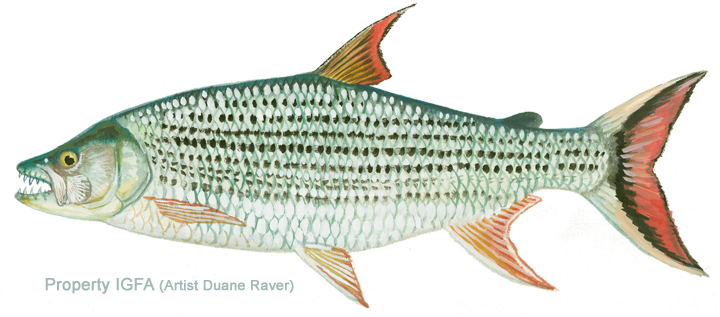Game Fish Identification Reference Guides
Tigerfish
(Hydrocynus vittatus)
(Hydrocynus vittatus)

(Castelnau, 1861) CHARACIDAE FAMILY; also called tiervis, ngweshi, maluvali, mcheni, muvanga, manga, shabani, simu kuta, uthlangi, uluthlangi
Vittatus tigerfish has a wide distribution from west Africa to the Nile and southward to the Zaire, Zambezi, and Limpopo systems. It occurs in Lake Turkana (L. Rudolph) which was once connected to the Nile but has not been able to cross the Murchison Falls and reach Lake Victoria nor has it been able to colonize Lake Kivu from Lake Tanganyika.
The tigerfishes belong to the Characidae family, a large and diverse family containing "toothy critters" such as the potentially dangerous piranhas, biara and payara found in South America and the beautiful tetras and pacus familiar to home aquarists.
They are more vividly colored than the larger goliath tigerfish with silvery flanks and a bluish sheen on the back. The deeply forked caudal fin is red edged with black, the adipose fin is black anteriorly, clear posteriorly. The pectoral and pelvic fins are tinged with red or orange as is the anterior part of the anal fin. Black horizontal stripes run through each scale row and persist long after death. They also have gill rakers that are long, approximately equal to the gill filaments. They grow to about 34 lbs (15.5 kg).
They are efficient active predators, feeding on fish up to 40% of their own length. They have fantastic appetites, and readily take artificial lures, live bait such as the Lake Tanganyika sardines (kapenta) and even prey on their own species.
The tigerfishes are among the best known and most important game fishes in Africa, commanding high respect amongst anglers, and as such, an important asset to the tourist industry. They are one of the most important components of commercial catches
Vittatus tigerfish has a wide distribution from west Africa to the Nile and southward to the Zaire, Zambezi, and Limpopo systems. It occurs in Lake Turkana (L. Rudolph) which was once connected to the Nile but has not been able to cross the Murchison Falls and reach Lake Victoria nor has it been able to colonize Lake Kivu from Lake Tanganyika.
The tigerfishes belong to the Characidae family, a large and diverse family containing "toothy critters" such as the potentially dangerous piranhas, biara and payara found in South America and the beautiful tetras and pacus familiar to home aquarists.
They are more vividly colored than the larger goliath tigerfish with silvery flanks and a bluish sheen on the back. The deeply forked caudal fin is red edged with black, the adipose fin is black anteriorly, clear posteriorly. The pectoral and pelvic fins are tinged with red or orange as is the anterior part of the anal fin. Black horizontal stripes run through each scale row and persist long after death. They also have gill rakers that are long, approximately equal to the gill filaments. They grow to about 34 lbs (15.5 kg).
They are efficient active predators, feeding on fish up to 40% of their own length. They have fantastic appetites, and readily take artificial lures, live bait such as the Lake Tanganyika sardines (kapenta) and even prey on their own species.
The tigerfishes are among the best known and most important game fishes in Africa, commanding high respect amongst anglers, and as such, an important asset to the tourist industry. They are one of the most important components of commercial catches













